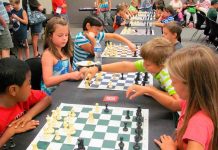Интегрированный урок (литература + английский) по теме «Война и мир» Льва Толстого в экранизациях на основе художественного фильма
«Война и мир» (СССР, 1968 г) и «War and Peace» (США, 1956)
18 апреля 2013г.
10 класс
Герасимова Елена Ильинична – учитель русского языка и литературы
Шевелева Татьяна Константиновна — учитель английского языка
Развивающие и воспитательные цели урока:
-
продолжить формирование навыков анализа художественного произведения;
-
формирование навыков сравнения художественного произведения и режиссерского сценария;
-
развитие умения смотреть и понимать фильмы на английском языке;
-
развитие навыков литературного перевода;
-
развитие умения понимать звучащую речь;
-
развитие социокультурной компетенции;
-
развитие межпредметной связи с художественной литературой;
-
развивать устную и письменную речь, эмоционально-образное, аналитическое мышление;
-
развитие чувства красоты художественного слова.
Оборудование: компьютер, проектор, мультимедийная презентация, видеофрагменты художественных фильмов, технологическая карта, текст романа «Война и мир».
Ход урока.
1.Вступительное слово учителя.
Здравствуйте, ребята. Сегодня мы с вами продолжим разговор о романе «Война и мир», продолжим анализ отдельных эпизодов для того, чтобы вы могли глубже понять замысел писателя, постичь мастерство автора в создании образов, оценить красоту и силу слова Толстого И поможет нам в этом не только художественное произведение «Война и мир», но и экранизации этого романа как на русском, так и на английском языке. Работать будем в группах, у каждого на столе лежат распечатанные задания, которые вы будете выполнять в ходе урока. (слайд 1)
2. Беседа по вопросам 1 части 5 и 6 глава. (слайд 3)
1. Объясните, что может вызвать осложнение болезни mademoiselle Шерер?
2. Как вы считает, получится ли из Пьера кавалергард или дипломат?
3. Почему князь Андрей дает Пьеру такой странный совет: «Выбери что хочешь; это все равно»?
4. Как характеризует разговор с княгиней Лизой князя Андрея и Пьера Безухова?
5. Почему князь Андрей решил идти на войну?
6. Почему Пьер пошел к Анатолю Курагину, несмотря на данное слово?
7. Как ведет себя Пьер на вечеринке у Курагина?
8. Каким вы себе представили князя Андрея и Пьера Безухова? Запишите в таблицу характеристику этих героев, используя имена прилагательные и существительные. (Учащиеся заполняют таблицу, после чего зачитываются характеристики).
3. Переход к понятию экранизация и интерпретация.
Учитель. Я предлагаю вам попытаться дать определение такому понятию, как «экранизация» (учащиеся записывают свои варианты, озвучивают. Варианты учащихся сравниваются с определением из словаря С. Ожегова) слайд 4.( Экранизация – взятие произведения (преимущественно литературного) в основу создания кинофильма. Словарь С.И.Ожегова)
Учитель. История экранизаций произведений литературы, имеющая немало побед на своем пути, является одним из частных примеров истинной близости между искусствами. Но именно эта же история свидетельствует также о том, что литература, театр и кинематограф – искусства различные, имеющие свои тайные и явные особенности, свои способы воздействия на ум и чувства человека, располагающие разными способами воплощения художественных образов, своим специфическим языком. Специфика кино, опирающегося прежде всего на зрительный образ, существенно отличает кинофильм от любого литературного произведения. «Одна сцена, или эпизод, или даже жест, мимика героя на экране способны в сконцентрированной форме воплотить в себе то, что, являясь предметом описания в литературе, может быть растянутым на десятки страниц», — пишет Л. Зайцева. Исходя из этого можно уверенно утверждать, что любая экранизация – это интерпретация, осуществляя которую приходится мысленно демонтировать литературное произведение.
Учитель. Дайте определение понятия «интерпретация». (Предполагаемый ответ учеников. Интерпретация (от лат. interpretatio – объяснение) — не просто истолкование произведения. Интерпретация, как правило, сопряжена с переводом высказывания на иной язык, с его перекодировкой. Толкуемое явление при этом «как-то меняется, преображается; его второй, новый облик, отличаясь от первого, исходного, оказывается одновременно и беднее, и богаче его. Интерпретация – это избирательное и в то же время творческое (созидательное) овладение высказыванием»). (слайд 5)
Учитель. Вы совершенно правы. Так режиссер, прорываясь к той реальности, которая воплощена в данном произведении, видит ее словно двойным зрением: глазами экранизируемого писателя и своими собственными. Второе никогда не совпадает с первым даже в такой киноленте, которая ориентирована на оптимальное приближение к литературному тексту.
Отбор произведений литературы для экрана и их трактовка всегда исторически обусловлены. Они определяются требованием и характером самого времени и особенностями личности художника, его мировоззрением, своеобразием его таланта. Погожева отмечает, что, как правило, «модернизация классических сюжетов не может привести к успеху, но иногда бывают исключения. Если произведение литературы написано автором с расчетом на выявление того, что можно назвать общечеловеческим, и если автор и режиссер очень талантливы и обладают своим, продуманным взглядом на внутренний поэтический образ экранизируемого произведения, то им удается создать яркое, убедительное произведение киноискусства».
Нельзя недоучитывать, что экранизация произведений прошлых лет неизбежно будет читаться зрителем в контексте другого, нового времени. В этом смысле, бесспорно, прав Товстоногов, утверждая: «Поворот к современному зрителю необходим, но границы должны быть поставлены верностью духу автора». С новым прочтением того или иного классического произведения можно согласиться, когда новизна экранизации будет извлечена из замысла или идеи «старого» авторского содержания.
Итак, кино и литература – это два вида искусства, каждый из которых обладает присущим только ему набором художественных средств и особенностей. В силу этого любая экранизация литературного произведения – это его интерпретация, предполагающая творческое преобразование исходного материала. Кроме того, создателю фильма необходимо учитывать запросы и актуальные проблемы своего зрителя, который живет в иное время, чем автор, создавший литературное произведение. Поэтому ценность интерпретации обуславливается не прямой близостью к оригиналу, а верностью духу и пафосу первоисточника. (слайд 6)
4. Переход к просмотру и обсуждению экранизаций.
Сегодня мы с вами будем говорить об экранизации романа «Война и мир». Мировая киноиндустрия обращалась к экранизации этого романа не один раз: самая первая экранизация была сделана еще в эпоху немого кино, вторая экранизация была сделана в Голливуде в 1956 году (слайд 7), следующая версия 1968 года принадлежит советским кинематографистам (слайд 8). Через несколько лет, в 1972 году, Великобритания снимает свою версию экранизации этого романа (слайд 9). Самая последняя версия была снята в 2007 году при совместном участии нескольких стран (слайд 10). Можно, конечно, обсудить все эти версии, но я предлагаю вам сегодня остановиться на 2 версиях: 1956 года, Голливуд, и 1968, СССР (слайд 11).
Начнем с советской версии. Роль Болконского сыграл Вячеслав Тихонов (слайд 12), а роль Пьера Безухова (слайд 13) сыграл режиссер фильма, Сергей Бондарчук. (История создания).
Мы с вами начнем просмотр эпизода беседы Болконского и Безухова в библиотеке. Во время просмотра вам необходимо будет записать характеристику этих двух героев так же, как вы делали несколько минут назад, но только, опираясь просмотренный фрагмент фильма (просмотр эпизода фильма со сцены беседы Болконского с Безуховым в библиотеке и до конца сцены кутежа у Курагина).
Каким вы увидели здесь Болконского, Безухова? Соответствуют ли они тому, какими вы себе их представляли во время чтения романа? (обсуждение с учащимися).
5. Просмотр голливудской экранизации на английском языке и дальнейшее выполнение заданий по английскому языку (сцена кутежа у Курагина и до беседы Болконского с Безуховым, где Болконский объясняет причины своего отъезда на войну).
Background information
War and Peace is the first English-language film version of the novel War and Peace by Leo Tolstoy. It is an American/Italian version, directed by King Vidor and produced by Dino De Laurentiis and Carlo Ponti. The music score was by Nino Rota and the cinematography by Jack Cardiff. The film was made by Dino de Laurentiis Productions and distributed by Paramount Pictures.
The film stars Audrey Hepburn, Henry Fonda, and Mel Ferrer, along with Vittorio Gassman, Herbert Lom and Anita Ekberg, in one of her first breakthrough roles. It was awarded the Golden Globe for Best Foreign-Language Foreign Film and it had Academy Awards nominations for Best Director (King Vidor), Best Cinematography, Color (Jack Cardiff) and Best Costume Design, Color (Maria De Matteis).
Differences from the novel
The film script had to condense the extensive original. It is primarily focused on Natasha, Pierre, and Andrei, their complex relationship and personal maturation on the backdrop of the historical events of the Napoleonic invasion. In Moscow, most of the scenes take place at the Rostov residence, and episodes at the country estates are curtailed, with some exceptions such as the hunt where Natasha first meets Andrei. This is a condensation of two scenes at the Rostov country estate, since in the novel Andrei, who by then is already Natasha’s fiancé, is not present at the hunt. There are no scenes from St. Petersburg. The relationship between Nikolas, Sonya and Mary is toned down. Historical figures that are retained are General Kutuzov and Napoleon. Minor battles are omitted, while Napoleon’scrossing of the Berezina is added. The concept of the inner dialogue is retained, notably in regard to Natasha, however, the extensive use of French is not retained in the movie. Events of the epilogue are not included in the movie, nor are Tolstoy’s discourses about history.
-
Чтение
-
Read the review and say if the author liked the film or not.
Review
Para1
The sheer enormity of Leo Tolstoy’s epic novel War and Peace has always deterred filmmakers from attempting an adaptation. Not only does the novel have a great number of complex characters over several years, but it includes many spectacular episodes (the battle scenes, the evacuation and subsequent wrecking of Moscow, the French retreat, etc) which could only be realised on a colossal budget. This international production was only the second filmed version of the novel, the first being a silent Russian film released in 1915.
Para 2
With a budget estimated to be around six million dollars, the film was shot in Europe (to keep the costs down) with an international cast and crew over a four-month period. Vidor’s first edition of the film ran to almost six and half hours, but this was cut by about a half at the insistence of his bosses at Paramount to make it more commercially viable. Even at three and a quarter hours, the film feels over-long and static, failing to evoke more than a shadow of the greatness of the original novel. Not surprisingly, the film was a box office flop and few critics responded kindly to it. Today, it is overshadowed by what are considered to be two definitive adaptations of the novel – a seven hour long Russian film by director Sergei Bondarchuk (released in 1967) and a twenty-part BBC TV series first transmitted in 1972.
Para 3
The film’s biggest failing is the casting choice for the three lead roles. Even Henry Fonda (Count Pierre Bezukhov) had to admit he was miscast, and he proves the fact by playing his part as if he were a half-comatose sheriff in low budget western. Equally baffling is the choice of Mel Ferrer(Prince Andrei Bolkonsky)for the other male lead – characterless and unsympathetic, the actor appears completely lost in a role that is somewhat beyond his abilities. Audrey Hepburn is also miscast in the female lead, but at least her portrayal of Natasha Rostova manages to capture something of Tolstoy’s flawed heroine – the unsullied purity and resilience that symbolise a Russia determined to see off Napoleon and his armies.
Para 4
Whilst its first half feels like a sagging historical soap opera, the film redeems itself in its second half with some stunning visuals, which include some of the most spectacular battle sequences to appear in a film of this era. This presumably is where most of the money went – in authentic recreations of the scenes of battle that employed thousands of extras and adhered rigorously to period detail, images that capture the sound and fury of the Napoleonic wars like no other film before and few others since.
Para 5
This version of War and Peace may have its failings, but it is definitely worth seeing for its vivid portrayal of Napoleon’s ill-fated Russian invasion.
Glossary
deter — make somebody decide not to do something
flop — a film/movie, play, party, etc. that is not successful
miscast — to choose an actor to play a role for which they are not suitable
redeems itself — to do something to improve the opinion
stunning — impressive
-
In pairs discuss the following questions and underline the parts in the text which help you answer them.
Para1
-
What are the main things the producers attempted to show in the film? ( Key — a great number of complex characters over several years, the battle scenes, the evacuation and subsequent wrecking of Moscow, the French retreat, etc)
-
Is it the first filmed version of the novel? ( Key — This international production was only the second filmed version of the novel, the first being a silent Russian film released in 1915.)
Para2
-
Did the filmmakers manage to show the greatness of the original novel? (Key — No: Even at three and a quarter hours, the film feels over-long and static, failing to evoke more than a shadow of the greatness of the original novel.)
-
Why was it a box office flop? (Key — … the film feels over-long and static…)
Para 3
-
What is the biggest failing of the film? Why? (Key — The film’s biggest failing is the casting choice for the three lead roles.)
Para4&5
What makes the film worth watching? (Key — … but it is definitely worth seeing for its vivid portrayal of Napoleon’s ill-fated Russian invasion.)
-
Работа с фильмом
1. Preview (c 13.30 мин. до 18.40 мин.)
You are going to watch a short episode from the film but before that look at the sentences and decide which of them may be about the book (B) and which are about the film (F).
-
It is primarily focused on Natasha, Pierre, and Andrei, their complex relationship and personal maturation. ___ (Key — F)
-
It describes intensely the historical events of the Napoleonic invasion. ___ (Key — B)
-
In Moscow, most of the scenes take place at the Rostov residence, and episodes at the country estates are curtailed, with some exceptions such as the hunt where Natasha first meets Andrei. ___ (Key — F)
-
Andrei, who is already Natasha’s fiancé, is not present at the hunt at the Rostov country estate. ___ (Key — B)
-
There are no scenes from St. Petersburg. ___ (Key — F)
-
The relationship between Nikolas, Sonya and Mary is toned down. ___ (Key — F)
-
Historical figures that are retained are General Kutuzov and Napoleon. ___ (Key — F)
-
Minor battles are omitted, while Napoleon’s crossing of the Berezina is added. ___ (Key — F)
-
We can see the extensive use of French. ____ (Key — B)
-
There are a lot of discourses about history. ___ (Key — B)
-
While watching
Now watch the film and make notes to answer the following questions
-
What does Pierre want to discover?
Use the key words to make complete sentences: happiness, suffering,war, God, love.
Key — Pierre wants to discover
-
what happiness is.
-
what value there is in suffering.
-
why men go to war.
-
what they really say deep in their hearts when they pray to God.
-
what it is that men and women feel when they say they love.
-
Why does Andrey go to war?
Choose the correct variant.
-
He thinks that Napoleon is a monster.
-
He believes that they have some business fighting Austria’s battles.
-
He thinks that Russia will be a great nation when the war is over.
-
He can’t stand to be married.
Key — d
-
Complete the phrases Pierre says.
-
You study, you become …….(Key — …enlightened)
-
I study, I become ….. (Key — …confused)
-
You love, you …… Key — … (marry)
-
You believe, you … (Key — …act)
-
There’s a war, you…. (Key — …serve)
-
After watching
-
Can you answer the questions that Pierre wants to find answers to?
-
What is happiness?
-
What value is there in suffering?
-
Why do men go to war?
-
What do they really say deep in their hearts when they pray to God?
-
What is it that men and women feel when they say they love?
-
Listen to the description and guess which character is described.
This personage is regarded as a reflection of Tolstoy himself, attracts our sympathy as an outsider to the Russian upper classes. The simplicity and emotional directness contrast with the artificiality of fakes such as the Kuragins. Though the guests at Anna Pavlovna’s party consider this person socially unacceptable and awkward, this very awkwardness emphasizes the natural unpretentiousness. We see his love of fun and excessive partying, and his generosity toward friends and acquaintances. This person, though intelligent, is not dominated by reason, as his friend Andrew is. There is also a great nobility in his emotions, and his search for meaning in his life becomes a central theme of the novel. (Key — Pierre Bezukhov)
This person, though as noble a soul as Pierre, differs from him in important ways that make him a very distinct character, and that illustrate Tolstoy’s philosophy of life. This person has a highly intelligent and analytical mind, as we see in the profitable way he runs his estate. He is devoted to his country, returning to active duty even after nearly being killed. This person, though often detached, is emotionally honest and willing to examine mysteries in himself. (Key — Andrew Bolkonski)
This person is a representation of joyful vitality and the ability to experience life fully and boldly, lively and spontaneous.From infancy to adulthood, this person charms everyone though never comes across as a show-off or a flirt angling for men’s attentions. The simplicity of the character sometimes makes her naïve. She changes radically by the end of the novel. (Key — Natasha Rostova )
-
Which main character can you describe using the three sets of phrases? Give some prove.
-
simplicity
emotional directness
awkward
natural unpretentiousness
love of fun
generosity
intelligent
not dominated by reason
a great nobility
(Key — Pierre Bezukhov)
B. has a highly intelligent and analytical mind
devoted to his country
often detached
emotionally honest and willing to examine mysteries in himself
free from search for the meaning of life
unable to forge deep and lasting connections with others
unwilling to forgive their misdeeds
a lonely individual
(Key — AndrewBolkonski)
-
a representation of joyful vitality and the ability to experience life fully and boldly.
lively
spontaneous
charms everyone
never comes across as a show-off or a flirt angling for men’s attentions
sometimes naïve
changes radically by the end of the novel, growing wise
(Key — Natasha Rostova)
-
Themes are the fundamental and often universal ideas explored in a literary work. One of the themes in War and Peaceis the Search for the Meaning of Life.
Several characters in War and Peace experience sudden revelations about the absurdity of existence.
Compare Andrey and Pierre. Eventually they both think about the falsity of life, how empty and artificial it is. But where does the difference lie?
(Key:
Andreyhas a near-death experience at Austerlitz that shows him a glimpse of the truth behind the falsity of earthly life.
Pierre spends most of the novel wondering why his life is so empty and artificial. The immediate cause of Pierre’s philosophizing is his marriage to the wrong woman, but his pondering goes beyond Helene alone, to include the vast mystery of why humans are put on Earth. Pierre’s involvement with the mystical practice of Freemasonry constitutes his attempt to give meaning to his life. Tolstoy, however, shows the inadequacies of this approach, as Pierre grows bored with the Masons and dissatisfied with their passivity. Pierre’s involvement with politics, shown in his short-lived, crazy obsession with assassinating Napoleon, is equally shallow. What finally gives meaning to Pierre’s life is the experience of real love with Natasha.)
Do they find the meaning to their lives?
What about the author? What does he think about it? And you?
6. Обсуждение и сравнение экранизаций.
Сейчас вы просмотрели две версии и имеете возможность сравнить их.
-
Каковы ваши впечатления от просмотренных эпизодов?
-
Чем отличаются эти версии?
-
Каким вы увидели здесь князя Андрея? (слайды 30, 31, 32)
-
Каким вы увидели Пьера Безухова? (слайд 33)
-
Какой образ, на ваш взгляд, ближе образу, созданному Толстым?
-
Почему так отличаются эти две экранизации, созданные по одному и тому же роману?
-
Вывод. Сейчас я прошу вас подвести итог всему сказанному на этом уроке, ответив на вопрос: «Есть ли разница между произведением и его экранизацией?»
8. Рефлексия. У вас в конце вашего рабочего листа есть таблица, заполните ее.
-
Домашнее задание. Англ.яз. Write a review of the book “War and Peace”
Литература: читать 1 том, 2 часть.
10. Подведение итогов. Наш с вами урок подошел к концу. Спасибо всем за активную работу на уроке. Хочется надеяться, что наше с вами сотрудничество оказалось плодотворным (анализ работы учеников на уроке, выставление оценок)





